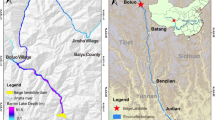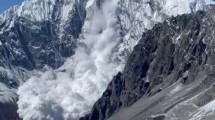Abstract
The increased use of complex and holistic modelling for multi-hazard analysis is in sharp contrast with a lacuna in hazard analysis in equatorial Africa. This study aims to increase understanding of multi-hazard events in poorly documented regions with low accessibility. We focus on the Nyamwamba catchment (107 km2) located in the Rwenzori Mountains (Uganda) where on May 1, 2013, a severe flash flood occurred. In this region, wildfires, earthquakes and landslides occur as well. Here we reconstruct the circumstances under which this flash flood event was triggered, characterize the different processes acting upon the catchment dynamics and estimate the damaging effects of the flash flood within the catchment. The combined occurrence of intense rainfall, a forest fire having burned 18 % of the catchment area and the occurrence of 29 landslides providing debris to the river system, induced a debris-rich and very destructive flash flood which caused several fatalities, the destruction of 70 buildings, several bridges, a hospital, a school, a tarmac road and several lifelines. Although the methodologies applied to estimate peak discharge, detect landslides and delineate wildfires are well established in their disciplines and sometimes limited in their precision, their combination is required to demonstrate the importance of the wildfire and landslides for the magnitude of this flood, unprecedented in decades but characterized by a low return period of the triggering rainfall event. This indicates that flash floods should not be considered as self-determined phenomena but as a result of several cascading and interacting hazard processes.

Source of the elevation data: SRTM 30 m (USGS 2014)















Similar content being viewed by others
References
ActAlliance (2013) Preliminary appeal UGANDA flash floods in Kasese—UGA131. http://reliefweb.int/sites/reliefweb.int/files/resources/UGA131Prel_KaseseFl.pdf. Accessed 22 Apr 2015
Barnes H (1967) Roughness characteristics of natural channels. USGS Surv Water Supply Pap 219:8–209
Binego A (2014) Causes of river Nyamwamba floods. http://www.newvision.co.ug/mobile/Detail.aspx?NewsID=651297&CatID=4. Accessed 15 Apr 2015
Brunner GW, Hunt JH (1995) A comparison of the one-dimensional bridge hydraulic routines from: HEC-RAS, HEC-2 and WSPRO. US Army Corps of Engineers, Hydrologic Engineering Center. http://www.hec.usace.army.mil/publications/ResearchDocuments/RD-41.pdf. Accessed 14 June 2016
Catane SG, Abon CC, Saturay RM et al (2012) Landslide-amplified flash floods—the June 2008 Panay Island flooding, Philippines. Geomorphology 169–170:55–63. doi:10.1016/j.geomorph.2012.04.008
Cheng JD, Huang YC, Wu HL et al (2005) Hydrometeorological and landuse attributes of debris flows and debris floods during typhoon Toraji, July 29-30, 2001 in central Taiwan. J Hydrol 306:161–173. doi:10.1016/j.jhydrol.2004.09.007
Chow V (1959) Open-channel hydraulics. McGraw-Hill Book Co., New-York
Conedera M, Peter L, Marxer P et al (2003) Consequences of forest fires on the hydrogeological response of mountain catchments: a case study of the Riale Buffaga, Ticino, Switzerland. Earth Surf Process Landf 28:117–129. doi:10.1002/esp.425
Coon WF (1998) Estimation of roughness coefficients for natural stream channels with vegetated banks. US Geol Surv Water Supply Pap 133:1–11
Cui P, Zhou GGD, Zhu XH, Zhang JQ (2013) Scale amplification of natural debris flows caused by cascading landslide dam failures. Geomorphology 182:173–189. doi:10.1016/j.geomorph.2012.11.009
DeBano LF, Neary DG, Ffolliott PF (1998) Fire’s effects on ecosystems. Wiley, New York
Department of Lands and Survey Uganda (1972) Topographic Map of Kasese sheet 66/3 1:50,000
Eggermont H, Van Damme K, Russell JM (2009) Rwenzori mountains (mountains of the moon): headwaters of the white Nile. In: Dumont HJ (ed) Nile Orig. Environ. Limnol. Hum. Use. Springer, Netherlands, pp 243–261. doi:10.1007/978-1-4020-9726-3_13
Fonstad M (2003) Spatial variation in the power of mountain streams in the Sangre de Cristo Mountains, New Mexico. Geomorphology 55:75–96. doi:10.1016/S0169-555X(03)00133-8
Friedel MJ (2011) Modeling hydrologic and geomorphic hazards across post-fire landscapes using a self-organizing map approach. Environ Model Softw 26:1660–1674. doi:10.1016/j.envsoft.2011.07.001
Gill JC, Malamud BD (2014) Reviewing and visualizing the interactions of natural hazards. Rev Geophys. doi:10.1002/2013RG000445
Goetz JN, Guthrie RH, Brenning A (2015) Forest harvesting is associated with increased landslide activity during an extreme rainstorm on Vancouver Island, Canada. Nat Hazards Earth Syst Sci 15:1311–1330. doi:10.5194/nhess-15-1311-2015
Google Earth (2010) Nyamwamba Valley February 15 2014, 0.25°N, 30°E, Digital Globe 2015. http://www.earth.google.com. Accessed 4 Apr 2015
Google Earth (2014a) Nyamwamba Valley February 15 2014, 0.25°N, 30°E, Digital Globe 2015. http://www.earth.google.com. Accessed 4 Apr 2015
Google Earth (2014b) Nyamwamba Valley January 13 2014, 0.25°N, 30°E, Digital Globe 2015. http://www.earth.google.com. 4 Apr 2015
GTK Consortium (2012) Geological map of Uganda 1:100,000 Sheet No. 65 Karambi
Guns M, Vanacker V (2013) Forest cover change trajectories and their impact on landslide occurrence in the tropical Andes. Environ Earth Sci 70:2941–2952. doi:10.1007/s12665-013-2352-9
Herschy R (2009) Streamflow measurement, 3rd edn. Taylor and Francis, New York
Hong Y, Adler R (2008) Predicting global landslide spatiotemporal distribution: integrating landslide susceptibility zoning techniques and real-time satellite rainfall estimates. Int J Sedim Res 23:249–257. doi:10.1016/S1001-6279(08)60022-0
Hungr O, Leroueil S, Picarelli L (2014) The Varnes classification of landslide types, an update. Landslides 11:167–194. doi:10.1007/s10346-013-0436-y
Jacobs L, Dewitte O, Poesen J, Delvaux D, Thiery W, Kervyn M (2015) The Rwenzori Mountains, a landslide-prone region? Landslides. doi:10.1007/s10346-015-0582-5
Jacobs L, Dewitte O, Poesen J, Maes J, Mertens K, Sekajugo J, Kervyn M (2016) Landslide characteristics and spatial distribution in the Rwenzori Mountains, Uganda. J Afr Earth Sci. doi:10.1016/j.jafrearsci.2016.05.013
Jarrett RD (1985) Determination of roughness coefficient in for streams in Colorado. Lakewood, Colerado
Jarrett RD (1989) Hydrologic and hydraulic research in mountain rivers. IAHS AISH Publ 190:107–117
Jordan P, Covert SA (2009) Debris flows and floods following the 2003 wildfires in Southern British Columbia. Environ Eng Geosci 15:217–234. doi:10.2113/gseegeosci.15.4.217
Kappes MS, Keiler M, von Elverfeldt K, Glade T (2012) Challenges of analyzing multi-hazard risk: a review. Nat Hazards 64:1925–1958. doi:10.1007/s11069-012-0294-2
Kasese District (2007) The Kasese district environment protection bill. Internal document
Kervyn M, Ernst GGJ, Harris A, Mbede E, Belton F, Jacobs P (2008) Thermal remote sensing of the low-intensity carbonatite volcanism of Oldoinyo Lengai, Tanzania. Int J Remote Sens 29:6467–6499
Kirby WH (1987) Linear error analysis of slope-area discharge determinations. J Hydr 96:125–138
Kizito BJ (2013) Kilembe floods. https://www.youtube.com/watch?v=4jTSBGRznBM. Accessed 16 Apr 2015
Laads Web (2013) Laads web level 1 and atmosphere archive and distribution system https://ladsweb.nascom.nasa.gov/. Accessed 20 Feb 2015
Langdale-Brown I, Osmaston HA, Wilson JG (1964) The vegetation of Uganda and its bearing on land use. Government of Uganda, Entebbe
LIDEFO (2013) Lidefo News-Kasese floods. http://lidefo-uganda.blogspot.co.at/2013/05/v-behaviorurldefaultvmlo.html. Accessed 22 Apr 2015
Lumbroso D, Gaume E (2012) Reducing the uncertainty in indirect estimates of extreme flash flood discharges. J Hydrol 414–415:16–30. doi:10.1016/j.jhydrol.2011.08.048
Maki Mateso JC, Dewitte O (2014) Towards an inventory of landslide processes and the elements at risk on the Rift flanks West of Lake Kivu (DRC). Geo Eco Trop 38:137–154
Malamud BD, Turcotte DL, Guzzetti F, Reichenbach P (2004) Landslide inventories and their statistical properties. Earth Surf Process Landf 29:687–711. doi:10.1002/esp.1064
Mazzorana B, Comiti F, Fuchs S (2013) A structured approach to enhance flood hazard assessment in mountain streams. Nat Hazards. doi:10.1007/s11069-011-9811-y
Mertens K, Jacobs L, Maes J, Kabaseke C, Maertens M, Poesen J, Kervyn M, Vranken L (2016) The direct impact of landslides on household income in tropical regions: a case study on the Rwenzori Mountains in Uganda. Sci Total Environ. doi:10.1016/j.scitotenv.2016.01.171
Moody JA, Martin DA (2001) Post-fire, rainfall intensity-peak discharge relations for three mountainous watersheds in the Western USA. Hydrol Process 15:2981–2993. doi:10.1002/hyp.386
Murcott S (2012) Arsenic contamination in the world: an international sourcebook. IWA Publishing, London
Niang I, Ruppel OC, Abdrabo MA et al (2014) Africa. In: Barros VR, Field CB, Dokken DJ, Mastrandrea MD, Mach KJ, Bilir TE, Chatterjee M, Ebi KL, Estrada YO, Genova RC, Girma B, Kissel ES, Levy AN, MacCracken S, Mastrandrea PR, White LL (eds) Climate change 2014: impacts, adaptation, and vulnerability. Part B: regional aspects. Contribution of working group II to the fifth assessment report of the intergovernmental panel on climate change. Cambridge University Press, Cambridge, pp 1199–1265
NTV Uganda (2013) Online video report: Kasese floods situation: red-cross to ascertain number of missing persons. https://www.youtube.com/watch?v=kANu7O82iSM. Accessed 15 Mar 2015
OECD (2012) Global modelling of natural hazard risks: enhancing existing capabilities to address new challenges. http://www.oecd.org/science/Final%20GRMI%20report.pdf. Accessed 12 Aug 2015
Phillips JD (2002) Geomorphic impacts of flash flooding in a forested headwater basin. J Hydrol 269:236–250. doi:10.1016/S0022-1694(02)00280-9
Prein AF, Langhans W, Fosser G, Ferrone A, Ban N, Goergen K, Keller M, Tölle M, Gutjahr O, Feser F, Brisson E, Kollet S, Schmidli J, van Lipzig NPM, Leung R (2015) A review on regional convection-permitting climate modeling: demonstrations, prospects, and challenges. Rev Geophys. doi:10.1002/2014RG000475
PreventionWeb (2009) Global distribution of multiple hazards mortality risk. http://preventionweb.net/go/10605. Accessed 8 Dec 2015
Reliefweb (2013) Disaster relief emergency fund (DREF) Uganda: Kasese floods. http://reliefweb.int/sites/reliefweb.int/files/resources/Uganda%20Kasese%20Floods%20DREF%20operation%20MDRUG033.pdf. Accessed 4 May 2015
Reliefweb (2014) Five perish as fresh floods hit Kasese. http://reliefweb.int/report/uganda/five-perish-fresh-floods-hit-kasese. Accessed 5 May 2015
Shakesby RA, Doerr SH (2006) Wildfire as a hydrological and geomorphological agent. Earth Sci Rev 74:269–307. doi:10.1016/j.earscirev.2005.10.006
Taylor R, Aggrey K (2004) Review of river discharge records and gauging stations in the Rwenzori Mountains of Uganda November 2004. http://www.geog.ucl.ac.uk/about-the-department/people/academic-staff/richard-taylor/research/files/rwenzori_river_stations_review_july_2004.pdf. Accessed 22 Mar 2015
Thiery W, Davin E, Panits H-J et al (2015) The impact of the African Great Lakes on the regional climate. J Clim 28:4061–4085. doi:10.1175/JCLI-D-14-00565.1
Tropical Rainfall Measurement Mission Project (TRMM) (2015) Daily TRMM and Others Rainfall Estimate (3B42 V7 derived), version 7: Goddard Space Flight Center Distributed Active Archive Center (GSFC DAAC). http://disc.sci.gsfc.nasa.gov/datacollection/TRMM_3B42_daily_V7.html. Accessed 14 Jan 2016
UNDP (2013) Study of the flooding in Rwenzori Mountain for effective disaster risk management. Kampala. http://www.ug.undp.org/content/dam/uganda/docs/UNDPUg2014-Kasese%20Flooding%20Study2_FINAL.pdf. Accessed 4 May 2015
UNESCO (1966) Earthquake reconnaissance mission, Uganda, the Toro earthquake of 20 March 1966. http://unesdoc.unesco.org/images/0000/000077/007799EB.pdf. Accessed 1 May 2015
UNISDR (2014) Status report on implementation of Africa regional strategy and Hyogo framework for action, UNISDR AF. https://www.unisdr.org/we/inform/publications/35923. Accessed 20 April 2015
UNISDR (2015) Sendai framework for disaster risk reduction 2015–2030. Presented at the third world conference on disaster risk reduction, Sendai, Miyagi, Japan. http://www.preventionweb.net/drr-framework/sendai-framework. Accessed 25 April 2015
University of Hawai’i (2004) MODVOLC near-real-time thermal monitoring of global hot-spots. modis.higp.hawaii.edu. Accessed 10 Feb 2015
USGS (2014) Shuttle radar topography mission, 1 Arc second scenes SRTM1N00E030V3, SRTM1N00E029V3, SRTM1S01E030V3, SRTM1S01E029V3, Unfilled Unfinished, Global Land Cover Facility, University of Maryland, College Park, Maryland, February 2000
USGS (2015) USGS Earthquake hazards program: search earthquake archives. http://earthquake.usgs.gov/earthquakes/search/. Accessed 5 May 2016
Wesche K, Miehe G, Kaeppeli M (2000) The significance of fire for afroalpine ericaceous vegetation. Mt Res Dev 20:340–347. doi:10.1659/0276-4741(2000)020[0340:TSOFFA]2.0.CO;2
Wright R, Flynn L et al (2002) Automated volcanic eruption detection using MODIS. Remote Sens Environ 82:135–155
Wright R, Flynn LP, Garbeil H et al (2004) MODVOLC: near-real-time thermal monitoring of global volcanism. J Volcanol Geotherm Res 135:29–49. doi:10.1016/j.jvolgeores.2003.12.008
Acknowledgments
We thank the VLIR UOS South Initiative Project (ZEIN2013Z145) and the BELSPO AfReSlide Project (BR/121/A2/AfReSlide) for financial support. Special acknowledgements go to the Kilembe Trekking Service, the Uganda Wildlife Authority, the Africa Nyamwamba Ltd, the Kasese District authorities and the Kilembe authorities, Mountains of the Moon University and all organizations and persons providing background reports and documenting the flood.
Author information
Authors and Affiliations
Corresponding author
Rights and permissions
About this article
Cite this article
Jacobs, L., Maes, J., Mertens, K. et al. Reconstruction of a flash flood event through a multi-hazard approach: focus on the Rwenzori Mountains, Uganda. Nat Hazards 84, 851–876 (2016). https://doi.org/10.1007/s11069-016-2458-y
Received:
Accepted:
Published:
Issue Date:
DOI: https://doi.org/10.1007/s11069-016-2458-y




